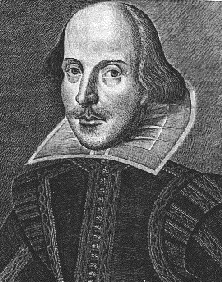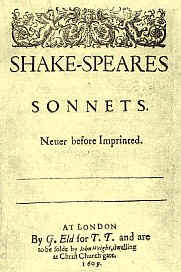

|
 |
 |
Introduction to Shakespearean Sonnets
The two main
forms of the sonnet are the Petrarchan (Italian) and the Shakespearean (English). Sonnets had been glorified by Petrarch in Italy
more than 200 years before English poets even knew about them. William Shakespeare's first
and second years in London were spent writing in the Petrarchan style. The Petrarchan
sonnet has an eight-line stanza, or octave, and six-line stanza, or sestet. The octave has
two quatrains, rhyming abba, abba, but
avoiding a couplet; the first quatrain gives the theme, and the second develops it. The
sestet is built on two or three different rhymes; the first three lines reflect on the
theme, and the last three lines bring the whole poem to an end. It differs from the Petrarchan sonnets in that it is
divided into three quatrains, each rhymed differently, with an independently rhymed
couplet at the end. The rhyme scheme of the
English sonnet is abab, cdcd, efef, gg. Each
quatrain takes a different appearance of the idea or develops a different image to express
the theme. All of Shakespeare's 154 sonnets
were in this form except for the poems he wrote earlier in life. The sonnets appear to extend from 1593 or 1594
until within a few years of their actual publication in 1609. His cycle is quite unlike the other sonnet
sequences of his day, notably in its idealization of a young man (rather than a sonnet
lady) as the object of praise, love, and devotion and in its portrait of a dark, sensuous,
and sexually promiscuous mistress (rather than the usual chaste and aloof blond beauty). Nor are the moods confined to what the Renaissance
thought were those of the despairing Petrarchan lover: they include delight, pride,
melancholy, shame, disgust, and fear. Shakespeare's sequence suggests a story, although
the details are vague, and there is even doubt whether the sonnets as published are in the
correct order. One hundred and one sonnets
were written to a young man. These have
variety of themes, such as the beauty of the loved one; destruction of beauty; competition
with a Rival Poet; despair about the absence of a loved one; and reaction toward the young
man's coldness.
Example: (Sonnet78) So
oft have I invoked thee for my Muse, (A) And
found such faire assistance in my verse, (B) As
every Alien pen hath got my use, (A) And
under thee their poesy disperse. (B) Thine
eyes, that taught the dumb on high to sing, (C) And
heavy ignorance aloft to flie, (D) Have
added feathers to the learned's wing, (C) And
given grace a double majestie. (D) Yet
be most proud of that which I compile, (E) Whose
influence is thine and born of thee, (F) In
others' works thou dost but mend the style (E) And
arts with thy sweet graces graced be. (F) But
thou art all my art, and dost advance (G) As high as learning my rude ignorance. (G) Sonnet 78
(above) is typical of Shakespeare's use of the English form of the sonnet with its rhyme
scheme of abab cdcd efef gg. In sonnet 78, the
first few lines reflect on the theme of his writings, and the last two lines bring the
sonnet to a conclusion. This sonnet clearly shows that Southhamptons (another poet who
later became a rival) is giving help to one or more rivals.
(1) Shakespearean Sonnets A
Shakespearean sonnet has three quatrains and a couplet, and rhymes abab cdcd efef gg. A
Shakespearean sonnet frequently introduces a subject in the first quatrain, expands it in
the second, and once more in the third, and concludes in the couplet. Italian (or Petrarchan) sonnets An Italian sonnet is composed of an octave, rhyming
abbaabba, and a sestet, rhyming cdecde or cdcdcd, or in some variant pattern, but with no
closing couplet. In both types, the content tends to follow the formal outline suggested
by rhyme linkage, giving two divisions to the thought of an Italian sonnet and four to a
Shakespearean one. The Italian sonnet develops and idea through eight lines and then
pauses, creating a turn or volta, before the concluding six.
Sonnet 1 to 17: Celebrates the beauty of a young man and urges him to
marry so as to propagate and preserve that beauty. Sonnet 18 to
126: The subsequent long sequence focuses on (probably) the
same ideal young man, developing as a dominant motif the transience and destructive power
of time, countered only by the force of love and friendship and the permanence of poetry. Sonnet 127 to
154: Focus on the so-called Dark Lady as a tempting but
degrading object of desire. Some sonnets (like 144) intimate a love triangle involving the
speaker, the male friend, and the woman; others take note of a rival poet (sometimes
identified as George Chapman or Christopher Marlowe). ˇ@ |